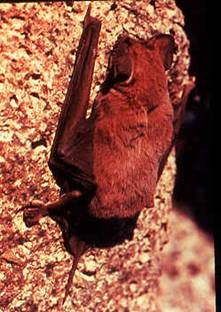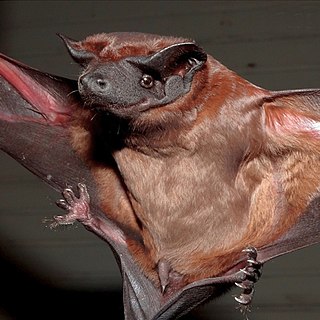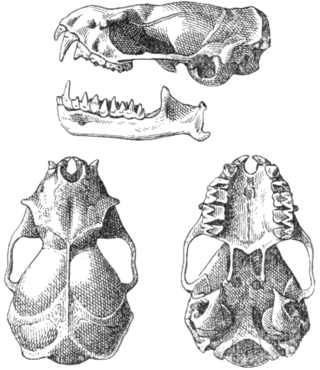
Vespertilionidae is a family of microbats, of the order Chiroptera, flying, insect-eating mammals variously described as the common, vesper, or simple nosed bats. The vespertilionid family is the most diverse and widely distributed of bat families, specialised in many forms to occupy a range of habitats and ecological circumstances, and it is frequently observed or the subject of research. The facial features of the species are often simple, as they mainly rely on vocally emitted echolocation. The tails of the species are enclosed by the lower flight membranes between the legs. Over 300 species are distributed all over the world, on every continent except Antarctica. It owes its name to the genus Vespertilio, which takes its name from a word for bat, vespertilio, derived from the Latin term vesper meaning 'evening'; they are termed "evening bats" and were once referred to as "evening birds".

The Molossidae, or free-tailed bats, are a family of bats within the order Chiroptera. The Molossidae is the fourth-largest family of bats, containing about 110 species as of 2012. They are generally quite robust, and consist of many strong-flying forms with relatively long and narrow wings with wrinkled lips shared through their genus. Their strong flying form allows them to fly 60 miles per hour using tail winds and at altitudes over 10,000 feet. This makes them unique among bats, as they are the only bat family that withstands the elevation. They are widespread, being found on every continent except Antarctica. They are typically found in caves, abandoned mines, or tunnels.

The cinnamon dog-faced bat, is a South American bat species of the family Molossidae. It is found in northern and central South America.

The rufous dog-faced bat, is a bat species found in Argentina, Brazil, Colombia, Guyana, Peru and Suriname.

The dwarf dog-faced bat is a species of free-tailed bat from South America. It is found in Argentina, Bolivia, Brazil, Colombia, Ecuador, Guyana, Peru, Paraguay and Uruguay, typically at lower elevations. It is one of two species in the genus Molossops, the other being the rufous dog-faced bat. Three subspecies are often recognized, though mammalogist Judith Eger considers it monotypic with no subspecies. It is a small free-tailed bat, with a forearm length of 28.9–32.5 mm (1.14–1.28 in) and a weight of 5–8 g (0.18–0.28 oz); males are larger than females. It is brown, with paler belly fur and darker back fur. Its wings are unusual for a free-tailed bat, with exceptionally broad wingtips. Additionally, it has low wing loading, meaning that it has a large wing surface area relative to its body weight. Therefore, it flies more similarly to a vesper bat than to other species in its own family. As it forages at night for its insect prey, including moths, beetles, and others, it uses two kinds of frequency-modulated echolocation calls: one type is to navigate in open areas and to search for prey, while the other type is used for navigating in cluttered areas or while approaching a prey item.

The Para dog-faced bat, also called the brown dog-faced bat, is a South American bat species of the family Molossidae. It is found in Panama, Colombia, Ecuador, Peru, Venezuela, Guyana, Suriname, French Guiana, Brazil, and northern Argentina.

Eumops is a genus of bats in the family Molossidae. A total of 17 species of this genus have been described. The name "Eumops" comes from the Greek prefix "Eu-", meaning "good" or "true," and the Malayan word "mops," which means bat.

Greenhall's dog-faced bat is a South American bat species of the family Molossidae. It is found in Colombia, Peru, Ecuador, Venezuela, the Guianas, northeastern Brazil and Trinidad.

The Natal free-tailed bat is a species of bat in the family Molossidae, the free-tailed bats. It is endemic to the island of Mauritius. It is known from fewer than five locations in its range, but it is common at a few sites. It roosts in caves, and it is considered to be an endangered species due to disturbance of its cave habitat.

The little goblin bat is a species of bat in the family Molossidae, the free-tailed bats. It is endemic to Cuba.

Ansorge's free-tailed bat is a species of bat in the family Molossidae native to sub-Saharan Africa. It is named for W.J. Ansorge, who collected the first formally described specimen.

Miller's mastiff bat is a species of bat in the family Molossidae. It is found in Brazil, Colombia, Costa Rica, Guyana, Mexico, Nicaragua, and Venezuela.

The blunt-eared bat or Peruvian crevice-dwelling bat is a species of bat in the family Molossidae. It is monotypic within the genus Tomopeas and subfamily Tomopeatinae. It is endemic to Peru, where it is considered critically endangered. It is threatened by habitat loss.

The Mexican dog-faced bat is a bat species of the family Molossidae from Central America. It is found from Nayarit in Mexico to Costa Rica at elevations up to 1500 m. It was formerly considered a subspecies of C. greenhalli. It roosts in deciduous and evergreen forest, and is usually found near small bodies of water.

The Florida bonneted bat or Florida mastiff bat is a species of bat in the genus Eumops, the bonneted bats or mastiff bats. Until recently, it was classified as a subspecies of Wagner's bonneted bat. It is endemic to southern Florida in the United States. This species has one of the smallest geographical distributions of any New World bat. It has been called "one of the most critically endangered mammal species in North America". It is protected under the Endangered Species Act.

Cynomops milleri is a species of bat that is native to South America. It was previously considered a subspecies of the Para dog-faced bat. It is considered a small- to medium-sized member of its genus. It is classified as least concern by the International Union for Conservation of Nature because it appears to be common and widespread. It is found in Venezuela, French Guiana, Guyana, Suriname, Brazil, and Peru.

Eumops ferox, the fierce bonneted bat or the chestnut mastiff bat, is a species of free-tailed bat found in the Caribbean and Mexico. Until recently, it was synonymous with Wagner's bonneted bat.

Molossus alvarezi, or Alvarez's mastiff bat, is a species of bat in the family Molossidae, native to the Yucatán Peninsula. It lives within a relative homogenous environment within perennial forests, low forests, and a band of xeric vegetation.


















